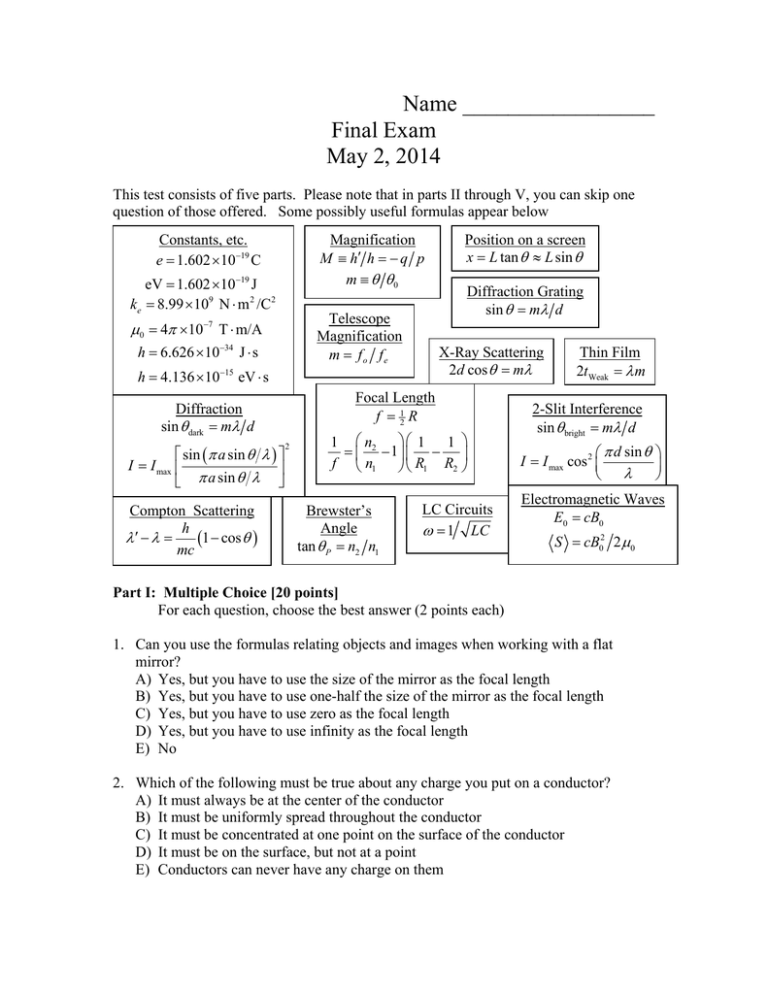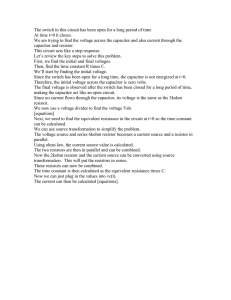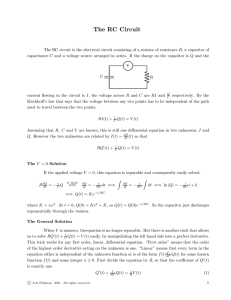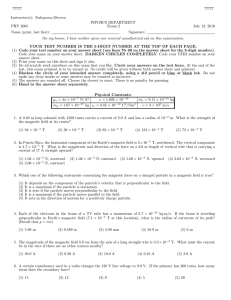Name _________________ Final Exam May 2, 2014
advertisement

Name _________________ Final Exam May 2, 2014 This test consists of five parts. Please note that in parts II through V, you can skip one question of those offered. Some possibly useful formulas appear below Constants, etc. e 1.602 1019 C Magnification M h h q p m 0 eV 1.602 1019 J ke 8.99 109 N m 2 /C2 Telescope Magnification m fo fe 0 4 107 T m/A h 6.626 1034 J s h 4.136 10 15 Focal Length f 12 R Diffraction sin dark m d Compton Scattering h 1 cos mc Diffraction Grating sin m d X-Ray Scattering 2d cos m eV s sin a sin I I max a sin Position on a screen x L tan L sin 2 1 n2 1 1 1 f n1 R1 R2 Brewster’s Angle tan P n2 n1 LC Circuits 1 LC Thin Film 2tWeak m 2-Slit Interference sin bright m d d sin I I max cos 2 Electromagnetic Waves E0 cB0 S cB02 2 0 Part I: Multiple Choice [20 points] For each question, choose the best answer (2 points each) 1. Can you use the formulas relating objects and images when working with a flat mirror? A) Yes, but you have to use the size of the mirror as the focal length B) Yes, but you have to use one-half the size of the mirror as the focal length C) Yes, but you have to use zero as the focal length D) Yes, but you have to use infinity as the focal length E) No 2. Which of the following must be true about any charge you put on a conductor? A) It must always be at the center of the conductor B) It must be uniformly spread throughout the conductor C) It must be concentrated at one point on the surface of the conductor D) It must be on the surface, but not at a point E) Conductors can never have any charge on them 3. How can a transformer change the voltage from high voltage to low voltage? A) There are resistors that reduce the voltage, acting as a voltage divider B) A capacitor stores the charge, then releases it at a lower voltage C) A diode only lets current through one way, but it is a lower voltage afterwards D) Charge is stored which creates an electric field, and a second wire feels the voltage and produces the lesser voltage E) A coil produces a changing magnetic field, a second coil with a different number of terms experiences a voltage due to the changing magnetic flux 4. One reason astronomical telescopes are so large in diameter is so they can gather lots of light. What is a second reason for this? A) Only large diameter telescopes can let in long wavelength light B) There is a physical limit to how small of angles can be resolved based on the size of the opening C) There is a maximum magnification that can be implemented for any given diameter D) It’s just a way to pad their budgets, bigger telescopes are more expensive E) Only with a large diameter can they view a large portion of the sky 5. A light ray coming in parallel to the optic axis for a concave mirror will, after reflection, pass through the ______ of the mirror A) Focus B) Center C) Vertex D) Radius E) None of the above 6. Which of the following is approximately a correct statement about the uncertainty of position and/or momentum based on quantum mechanics? A) There is a minimum position uncertainty for any particle B) There is a minimum momentum uncertainty for any particle C) There is a minimum for the sum of the position and momentum uncertainty D) There is a minimum for the product of the position and momentum uncertainty E) There is a minimum for the ratio of the position and momentum uncertainty 7. Electric field lines A) Start at positive charges and end at negative charges B) Start at negative charges and end at positive charges C) Always form closed circles around currents D) Are always parallel on the surface of conductors E) None of the above 8. What does it mean that there is a phase shift between the voltage and the current in an AC circuit? A) The two are not of the same magnitude B) The peaks and valleys of the current and the voltage do not occur at the same time C) The frequencies of the two are slightly different D) The voltage oscillates, but the current does not E) The current oscillates, but the voltage does not 9. When can we trust the results of geometric optics, also known as the ray approximation? A) When all apertures/holes/barriers, etc., are large compared to the wavelength B) When all apertures/holes/barriers, etc., are small compared to the wavelength C) Whenever we are detecting individual photons D) Whenever we are not detecting individual photons E) Whenever multiple wavelengths are being used simultaneously 10. Which of the following imaging system produces an image with no distortion or imperfect focus? A) A single thin lens B) A pair of matched thin lenses C) A single curved mirror D) A pair of matched curved mirrors E) A single flat mirror 11. Suppose light is moving in air, and hits water, but reflects off. How does the wavelength or frequency of the reflected wave compare to the incident wave? A) Frequency is the same but wavelength decreases B) Frequency is the same but wavelength increases C) Frequency decreases and wavelength increases D) Frequency increases and wavelength decreases E) Both stay the same 12. What happens if you charge up a capacitor, then connect the ends to a resistor? A) The capacitor will instantly discharge B) The capacitor will discharge gradually through the resistor C) The capacitor and resistor will trade energy back and forth, oscillating D) The capacitor will give its energy into the resistor, where it will stay E) Nothing, because the resistor doesn’t allow current through it 13. Ampere’s Law relates the integral of the magnetic field around a loop to what? A) The voltage through the loop B) The electric charge inside the loop C) The electric flux through the loop D) The current going through the loop E) The magnetic charge inside the loop 14. How do corner reflectors, such as you have in reflectors on cars and so on, work? A) They have detectors that sense the incoming light, then LED’s that send a signal back the way it came B) They have a single mirror that pivots in different directions based on the incoming light C) They have sets of three mirrors that always reflect the light back the direction it came from D) They have numerous tiny mirrors reflecting light in all directions, and one of them will be correct to reflect the light back E) They use optical fibers to take the light, loop it around, then send it back from where it came 15. A Michelson interferometer compares the distance between two long paths by A) Measuring the amount of time it takes light to go through each path B) Adding together the light that follows two paths, and seeing how much they combine constructively or destructively C) Forcing waves to fit exactly between mirrors on two different paths, and measuring how the wavelengths of the light compare D) Counting the exact number of waves along each of two paths and subtracting them E) Measuring the blurring of the image caused by the motion of one of the mirrors 16. The force on a moving charge in a magnetic field is ______ to the direction of motion and _____ to the direction of the magnetic field A) Perpendicular, perpendicular B) Perpendicular, parallel C) Parallel, perpendicular D) Parallel, parallel E) None of the above 17. Which type of electronic component is best at blocking low frequency AC sources while allowing high frequencies through? A) Capacitor B) Resistor C) Inductor D) Diode E) Battery 18. When light passes through a very small hole shaped like the one at right, what will the pattern of light look on a screen far away? A) It will tend to maintain this rectangular shape and size indefinitely B) It will tend to spread equally in both the vertical and horizontal directions C) It will spread out in both directions, but mostly in the vertical direction D) It will spread out in both directions, but mostly in the horizontal direction E) No significant light can make it through small holes 19. A capacitor with capacitance 2 F has a voltage 6 V on it. What is the charge on the capacitor? A) 121 C B) 13 C C) 3 C D) 12 C E) 24 C 20. In a velocity selector, a charged particle is in a strong magnetic field. Why does the charge move in a straight line anyway? A) It is moving parallel to the magnetic field, and hence feels no force B) It is moving perpendicular to the magnetic field, and hence feels no force C) It is so massive that the tiny force of the magnetic field has no effect D) It is moving so quickly that the force has little effect on it E) There is an electric field that cancels out the force from the magnetic field 21. How does placing a material in a capacitor increase the capacitance? A) It effectively increases the area of the capacitor B) It effectively increases the distance between the plates C) It adds extra charge to the capacitor plates D) It acts as a battery, changing the voltage E) Charges in the material shift, cancelling out part of the electric field 22. Inductors resist changes in A) Charge B) Voltage C) Current D) Power E) Inductance 23. The chromatic dispersion of a lens refers to the fact that A) The small angle approximation is not always accurate, and hence things don’t focus perfectly B) Lenses absorb a certain fraction of the light, ruining the image C) Lenses do not bend light of all frequencies the same, ruining the focus D) The shape of lenses is not perfect, making the image imperfect E) Because of the delay from the slowdown of different colors, the light doesn’t all arrive at the same time 24. According to Fermat’s principle, the path light takes from one point to another is always the one that takes the A) Most time B) Least time C) Shortest path D) Longest Path E) None of the above 25. How does the direction the charge carriers in a conductor move compare to the direction of current flow? A) They are the same, always B) They are always opposite directions C) They are the same if charge carriers are positively charged, and opposite if they are negatively charged D) They are the same if charge carriers are negatively charged, and opposite if they are positively charged E) None of the above Part II: Short answer, old material: [20 points] Choose two of the following three questions and give a short answer (2-3 sentences) (10 points each) 26. Suppose you want to know the total charge inside a box. Explain how you could, in principle, determine this without looking inside the box. An equation is advised. 27.Describe in words or equations Kirchoff’s two laws for circuits. You do not need to give a detailed description of how you apply it. 28. Explain qualitatively how an electric generator can create electrical power. A diagram is not necessary, nor do you have to explain what is rotating the relevant parts. Part III: Short answer, new material: [20 points] Choose three of the following four questions and give a short answer (2-3 sentences, or comparable) (10 points each) 29. As a beam of white light moves from air to glass, will its direction change? Give a relevant equation. Will all colors bend the same amount? Explain which colors are more likely to bend more. 30. Explain what a birefringent crystal is, and why a single beam of light can be divided into two beams by it 31. A curved mirror has a radius of R. What is its focal length? Draw a sketch or otherwise indicate how a mirror could have a positive or negative focal length 32 Explain qualitatively why it is that soap bubbles and thin films of oil sometimes appear to have detailed colors Part IV: Calculation, old material: [60 points] Choose two of the following three questions and perform the indicated calculations (20 points each) 33. A charge of +4.00 C is placed at the origin. A point P is 3.00 cm to the right of it. (a) What is the electric field at P? 3.00 cm + 4.00 C (b) What is the electric potential at P? (c) A proton (m = 1.67210-27 kg, q = 1.60210-19 C) at rest is now placed at the point P. What is its initial acceleration at P? (d) Eventually the proton gets very far away from the point charge. At this point, what is its velocity? P 34. An electric teapot is basically a resistor connected to a power source, which we’ll treat as a 120 V battery. Water has a specific heat capacity of 4.18 J/g/C (a) How much energy is required to heat 100.0 g of water from 20C to 100C? – + b 120 V R (b) Suppose it takes 3.00 minutes to heat it up this much. What is the rate of power consumption for the resistor? What is the current I? (c) Find the resistance of the resistor. 35. Flipping an electron’s spin in a hydrogen atom emits microwaves with a frequency of f 1.420 109 Hz . (a) Find the angular frequency , the period T, the wavelength , and the wave number k for this wave. (b) An astronomical source produces waves with an intensity S 1.08 1013 W/m 2 . Find the magnitude of the electric field E0 and the magnetic field B0 of this wave. (c) An astronomer is trying to make an LC circuit that vibrates at this exact frequency. He has already purchased an inductor with L 1.20 H . What capacitance should he use to get the right frequency? Part V: Calculation, new material: [60 points] Choose three of the following four questions and perform the indicated calculations (20 points each) 36. A light beam passing through a layer of flint glass (n = 1.62) moving at an angle of 40 compared to the perpendiular, passes into a layer of water (n = 1.33), and then continues towards a layer of air, as sketched at right (a) Assuming at least some of the light makes it into the water, calculate the angle compared to the perpendicular at which it enters the water. air water ’ 40 glass (b) Assume now that some of the light is reflected at the water-air interface, calculate the angle at which it is reflected, compared to the perpendicular. (c) For the second step, the water-air interface, is any of the light actually reflected? Is any of it transmitted? Explain why you believe your answer. 37. An object of size 1.00 cm is being examined through a thin lens. When the object is placed 20.0 cm in front of the lens, and examined through the lens, it appears to be 3.00 cm high, and upright (a) What is the apparent location of the image compared to the lens? What is the focal length of the lens? (b) The object is now moved to a distance such that it appears to be infinitely far away as viewed through the lens. What distance is it at? (c) Which of the four lenses sketched at right has the right shape for this lens? If it is made from cubic zirconium with index of refraction n = 2.16, and the two radii are equal in magnitude, what are those radii? 38. Helium produces a yellow spectral line with 588 nm and a violet spectral line with a wavelength you determine below. It is then passed through diffraction grating (a) The yellow light’s first order diffraction line is at an angle of 35.0. Determine the spacing of the diffraction grating. 2nd order 2nd order yellow violet violet yellow (b) The violet one is diffracted by an angle of 25.8. What is the wavelength for the violet line? (c) Find the angles for the second order diffraction for these two waves. Interestingly, only one of these two lines has a second order spectral line. Which one? 39. The work function for Gallium is 4.32 eV. (a) When light with frequency = 157.0 nm impacts on Gallium, what is the kinetic energy of the electrons that come off of it? (b) Waves of unknown frequency impact on Gallium, causing the emission of electrons with kinetic energy 2.01 eV. What is the frequency of the light? (c) What is the longest wavelength that can eject an electrons from Gallium?




